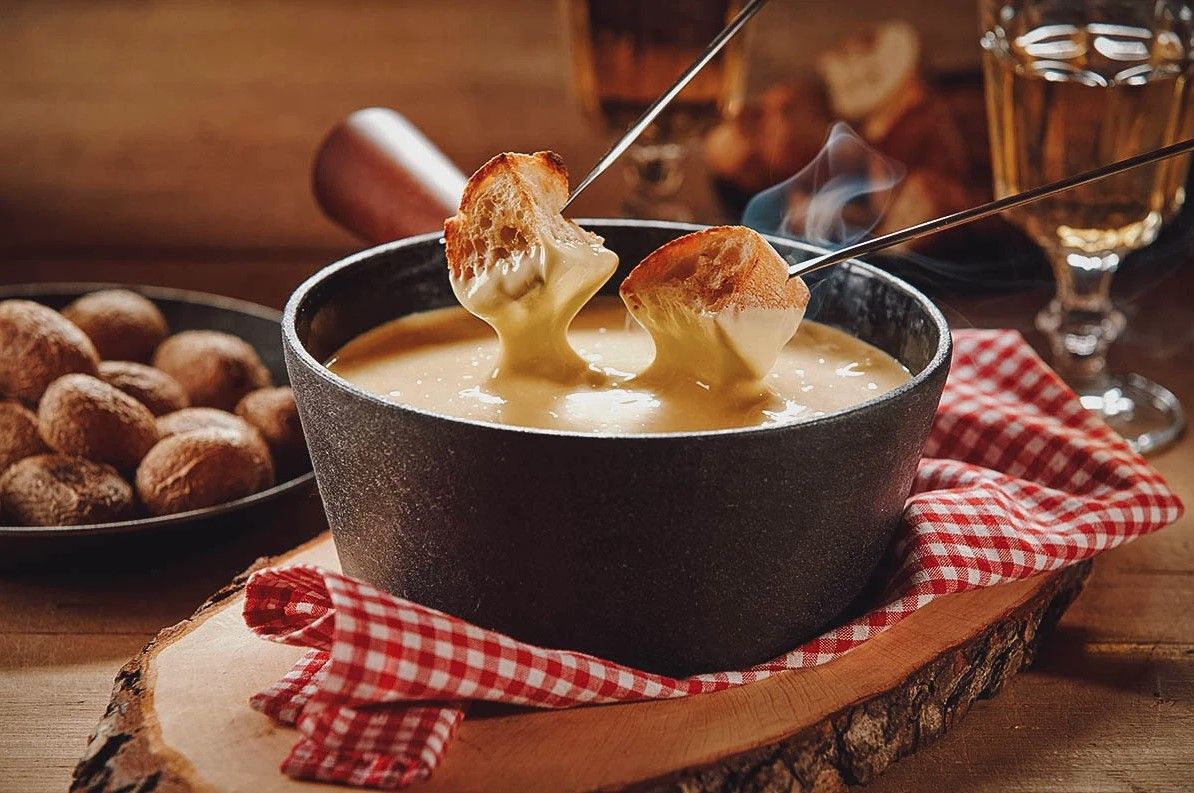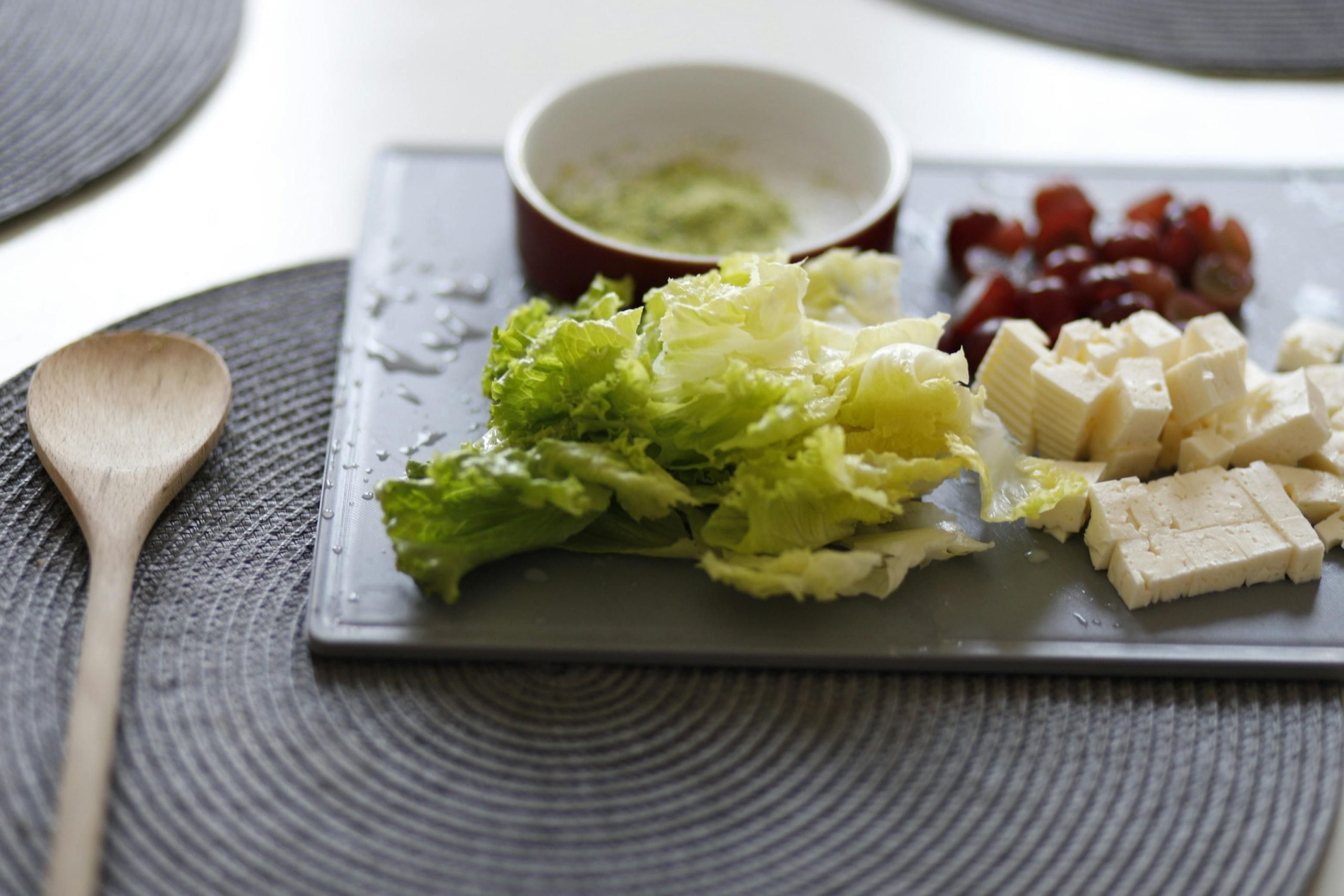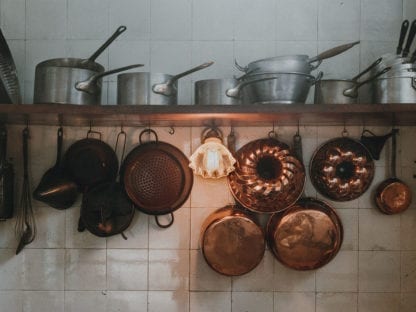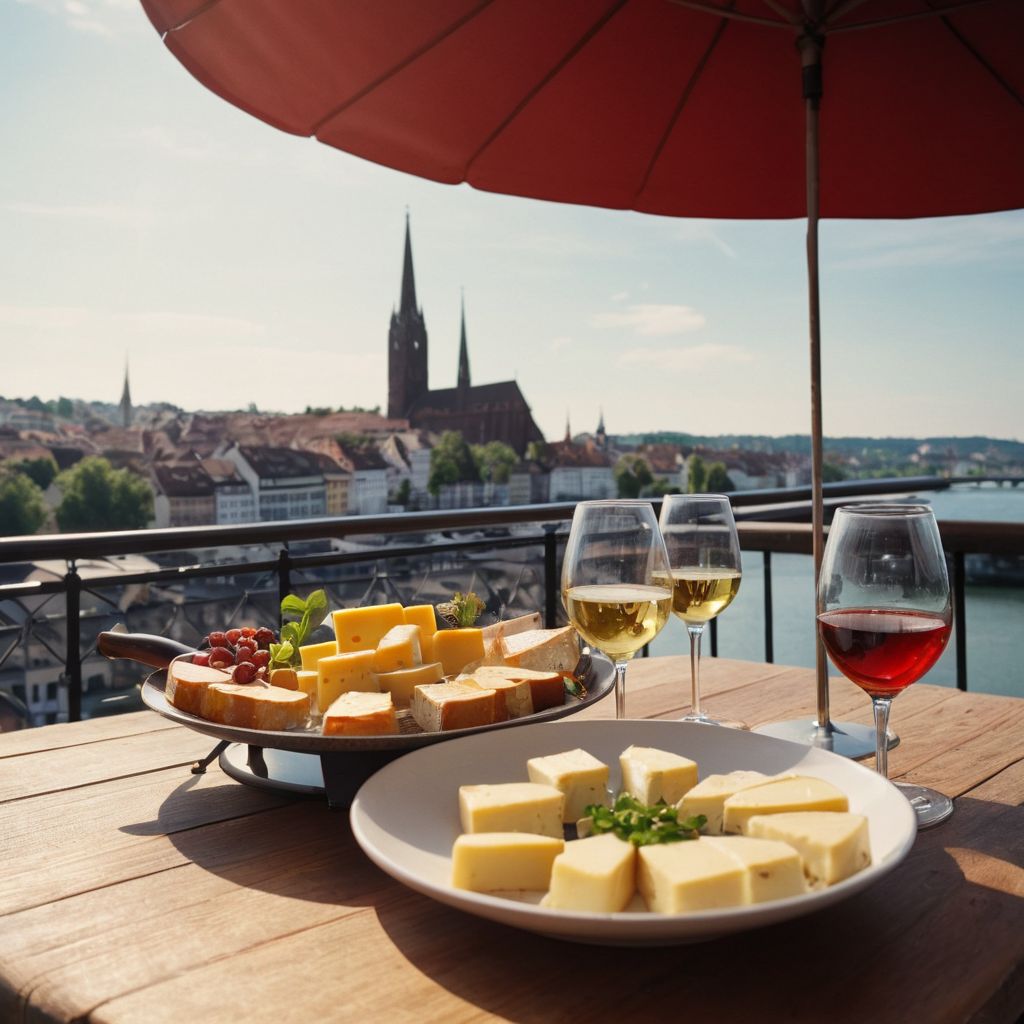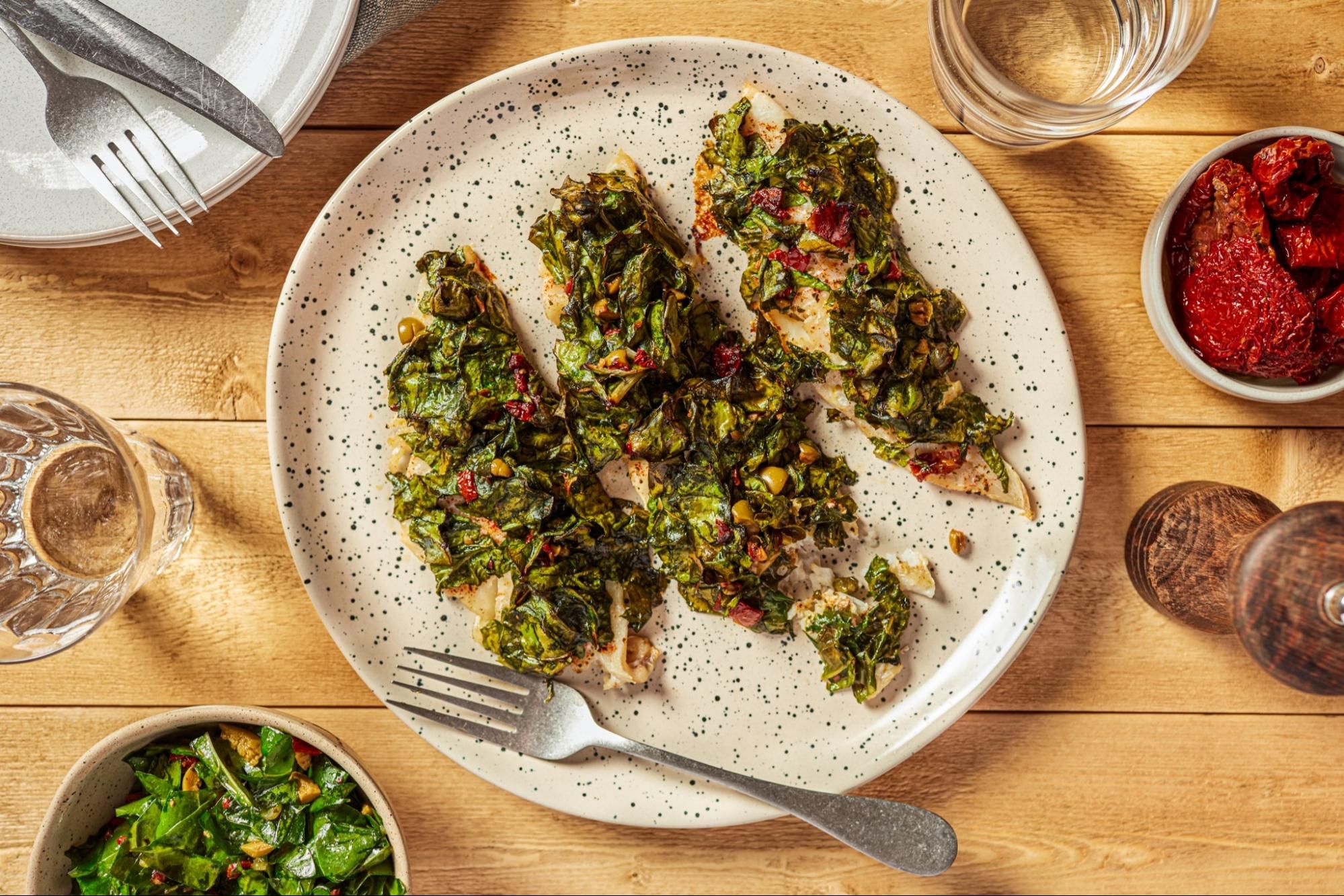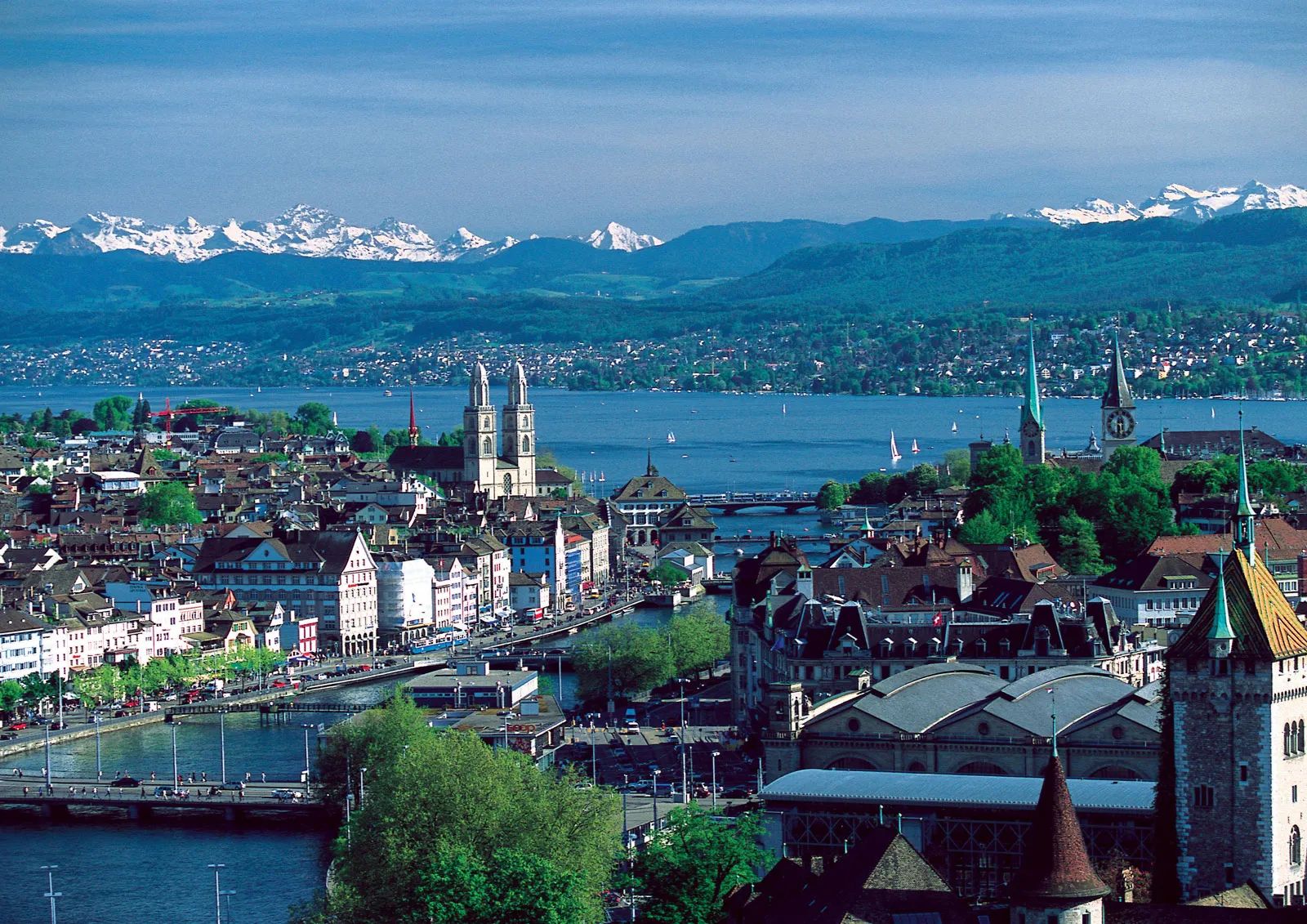Imagine melting cheese, hearty alpine dishes, and the rich aroma of buttery pastries filling your kitchen.
Navigating the diverse and comforting world of Swiss cooking can seem daunting, especially with its regional variations and unique ingredients.
Swiss cuisine offers a treasure trove of dishes developed in Switzerland or assimilated from neighbouring countries, featuring recipes and cooking techniques that highlight ingredients like cheese, beef, butter, and saffron.
This article will guide you through the heart of Swiss cooking traditions, from fondue to bündner nusstorte, providing insights into making these dishes at home and exploring the history and regional nuances that make Swiss cuisine so special.
Fondue: The Heart of Swiss Cooking Traditions

Swiss fondue isn’t just a dish; it’s a tradition that embodies the spirit of Switzerland. With its roots stretching back to the 17th century, fondue has evolved from a simple mix of cheese, wine, and bread to become a symbol of Swiss hospitality and communal dining. The essence of fondue lies in its simplicity and the joy of sharing a meal, making it a staple in Swiss homes and a must-try for anyone exploring Swiss culinary traditions. Whether enjoyed in a cozy mountain chalet or a bustling city restaurant, fondue creates an atmosphere of warmth and camaraderie that is hard to resist.
Making Swiss fondue at home is an enjoyable and straightforward affair, provided you have the right ingredients and utensils. At its core, a traditional Swiss fondue requires quality Swiss cheeses, white wine, and a dash of garlic to taste. The key to a smooth and flavorful fondue is the careful selection of cheeses, such as Gruyère and Emmental, which melt beautifully and add depth to the dish. Served with cubes of crusty bread for dipping, fondue is not just a meal but an experience, bringing people together and creating lasting memories over a pot of melted cheese.
Mastering Raclette: A Swiss Cooking Delight

Mastering raclette at home is simpler than one might think, and it’s a delightful way to bring Swiss culinary traditions into your dining room. Raclette, named after the cheese used to make it, is a dish that’s all about customization and communal dining. The essentials include raclette cheese, boiled potatoes, and a variety of sides like pickled onions and cornichons. With a raclette grill, guests can melt their own cheese and pair it with their choice of sides, making it a fun and interactive meal. The beauty of raclette lies in its simplicity and the joy of sharing, making it a perfect dish for gatherings.
Älplermagronen: Swiss Cooking from the Alps

Älplermagronen, often referred to as the Swiss version of macaroni and cheese, is a hearty dish that brings the essence of the Swiss Alps to your table. This comforting meal combines pasta, potatoes, cheese, and cream, topped with caramelized onions to create a rich and satisfying dish. Traditionally served with applesauce on the side, älplermagronen is a testament to Swiss ingenuity in creating filling and flavorful meals from simple ingredients. Learning to make this dish at home allows you to experience a piece of Swiss alpine cuisine, perfect for warming up after a day of skiing or hiking in the mountains.
Rösti: A Crispy Swiss Cooking Classic

Rösti, a crispy, golden delight, is more than just a dish; it’s a symbol of Swiss culinary heritage. Originating as a breakfast for farmers in Bern, this simple yet satisfying potato pancake has found its way into the hearts of people across Switzerland. Made primarily from grated potatoes that are pan-fried until they’re beautifully crisp on the outside while remaining tender on the inside, rösti showcases the Swiss knack for turning simple ingredients into something extraordinary. Its versatility has led to numerous regional variations, incorporating local flavors and preferences, which means there’s always a new rösti recipe to try.
Making rösti at home is a rewarding experience, and with a few tips, you can achieve that perfect balance of crispy and tender. Here are some key pointers:
- Choose the right potatoes: Waxy potatoes hold their shape and texture better during cooking.
- Pre-cook the potatoes: Boiling them before grating allows for a more even and quicker frying process.
- Be generous with butter: It not only prevents sticking but also adds a rich, golden color and flavor to the rösti. Whether you’re enjoying it as a side dish or making it the star of your meal with toppings like cheese, bacon, or a fried egg, mastering the art of rösti brings a piece of Switzerland into your kitchen.
Birchermüesli: Swiss Cooking for a Healthy Start

Birchermüesli, a Swiss creation by Maximilian Oskar Bircher-Brenner, offers a healthful start to the day, blending oats soaked in lemon juice with fresh fruits and nuts. This dish, originally designed for its nutritious benefits, has become a global breakfast favourite. Preparing birchermüesli at home is straightforward:
- Start by soaking oats in a mixture of water or milk and lemon juice.
- Grate a fresh apple, including the skin for added fibre, and mix it with the soaked oats.
- Enhance the flavour with a dollop of yogurt and a sprinkle of nuts or seeds for crunch.
This simple yet versatile Swiss dish not only provides a nutrient-packed breakfast but also allows for endless variations to suit any palate, embodying the essence of traditional Swiss foods with a focus on health and simplicity.
Zürcher Geschnetzeltes: A Swiss Cooking Favourite

Zürcher Geschnetzeltes is a creamy, mushroom-laden dish that has captured the hearts of many, both within and beyond the borders of Zurich. It’s a perfect example of how Swiss cuisine often combines simplicity with rich flavours to create something truly special. This dish, featuring thinly sliced veal in a creamy mushroom sauce, is a testament to the culinary ingenuity of Switzerland. It’s not just a meal; it’s a delicious journey through Zurich’s culinary landscape.
Preparing Zürcher Geschnetzeltes at home is surprisingly straightforward, allowing you to bring a taste of Zurich into your kitchen. Here are the basic steps:
- Brown the veal strips quickly in a hot pan.
- Sauté onions and thinly sliced mushrooms, then deglaze with white wine.
- Add cream and a hint of lemon zest to create the rich sauce.
This Swiss favourite is traditionally served with Rösti, making for a comforting and satisfying meal that’s perfect for any occasion.
Saffron Risotto: Luxurious Swiss Cooking

Saffron risotto, a dish that marries the culinary traditions of Ticino and Valais, stands as a testament to the luxurious use of saffron in Swiss cooking. This creamy risotto, infused with the rare and aromatic spice from the mountain village of Mund, showcases how a simple ingredient can elevate a dish to something truly extraordinary. The key to its rich flavour lies in:
- Using high-quality saffron, known as “red gold,” to ensure a vibrant colour and a subtle, unmistakable aroma.
- Carefully adding the saffron towards the end of cooking to fully release its aromatic qualities.
- Pairing the risotto with ingredients that complement, rather than overpower, the delicate flavour of the saffron. This Swiss-Italian fusion not only highlights the luxurious side of Swiss cuisine but also brings a piece of Switzerland’s culinary heritage to your table, making it a must-try for anyone looking to explore traditional Swiss dishes.
Bündner Nusstorte: A Sweet Swiss Cooking Tradition

Bündner Nusstorte, originating from the picturesque region of Graubünden, is a celebrated Swiss dessert that combines the rich flavours of caramel and nuts in a delectable pie. This traditional dish is a testament to the Swiss love for indulgent desserts, featuring a buttery crust filled with a sticky caramel and nut filling, usually walnuts. Its unique taste and texture make it a favourite among both locals and visitors, embodying the essence of Swiss pastry craftsmanship.
Baking Bündner Nusstorte at home is a rewarding experience that allows you to bring a piece of Swiss tradition into your kitchen. The process involves preparing a shortcrust pastry, caramelising sugar to create a luscious filling with chopped nuts, and assembling these components before baking to golden perfection. Here are a few key tips for success:
- Use quality ingredients: High-quality butter and fresh nuts make a significant difference in flavour.
- Be patient with the caramel: Cooking it to just the right consistency ensures the filling is both rich and sliceable.
- Let it cool: Allowing the tart to cool completely before slicing helps set the filling, making it easier to serve. Whether you’re a seasoned baker or new to Swiss recipes, creating your own Bündner Nusstorte is a delightful way to explore Swiss desserts.
Soupe de Chalet: Warming Swiss Cooking
Soupe de Chalet, a hearty Swiss soup from the Fribourg region, is the epitome of comfort food, ideal for warming up during the cold winter months. This traditional dish is simple to prepare, requiring basic ingredients such as potatoes, cheese, and sometimes pasta or vegetables, making it a perfect example of Swiss culinary ingenuity. The preparation involves:
- Boiling potatoes and other vegetables until tender
- Melting cheese into the mixture for a creamy consistency
- Adding pasta or bread for a more filling meal
The result is a rich, creamy soup that not only fills the stomach but also warms the heart, showcasing the simplicity and warmth of Swiss cooking.
Berner Platte: A Feast of Swiss Cooking
The Berner Platte is a lavish feast that captures the essence of Swiss culinary tradition, originating from a historic moment of victory. This dish is a testament to the Swiss spirit of community and celebration, comprising various meats, sauerkraut, potatoes, and beans. Each component is cooked separately, allowing for a rich blend of flavours and textures. The Berner Platte is not just a meal; it’s an experience that brings people together, making it a perfect dish for gatherings and special occasions.
Assembling a Berner Platte at home might seem daunting, but it’s a rewarding venture into Swiss cooking. Here are the basic steps to create your own feast:
- Cook the meats: Include a variety such as smoked bacon, boiling beef, and pork sausages.
- Prepare the sides: Boil potatoes, simmer sauerkraut, and cook beans until tender.
- Serve together: Arrange the potatoes, sauerkraut, and beans on a large plate and top with the meats. The beauty of the Berner Platte lies in its diversity, allowing guests to mix and match their preferred flavours. Whether for a festive occasion or a special dinner, this dish brings a piece of Swiss tradition to your table.
Bratwurst: A Staple of Swiss Cooking
Bratwurst, a popular Swiss sausage, holds a special place in the heart of Swiss cuisine. Its preparation is both an art and a tradition, showcasing the rich diversity of Swiss cooking. Whether it’s the famous St. Galler bratwurst, known for its delicate blend of milk, veal, and pork, or the larger OLMA bratwurst served at St. Gallen’s annual agricultural show, each type offers a unique taste experience. To make bratwurst at home, start with high-quality meat and follow traditional Swiss recipes for authentic flavour. Serving suggestions include:
- Pairing with Zwiebelsauce, a rich onion sauce, for a classic combination
- Accompanying with Rösti, the crispy Swiss potato pancake, for a hearty meal
- Enjoying with a simple side of mustard and fresh bread for a quick, satisfying dish. Embracing the tradition of making and serving bratwurst allows you to bring a piece of Swiss culinary heritage into your kitchen, making it a staple in exploring Swiss foods.
Elevate Your Swiss Cooking Experience with Zurich’s Culinary Tours
Exploring Zurich’s culinary landscape through curated culinary tours and exclusive dining experiences offers more than just a taste of Swiss cuisine; it provides a deep dive into the local food history and the unique flavours that define the region. By joining these tours, you’re not just eating; you’re engaging in a cultural journey that connects you with the essence of Swiss cooking. These experiences, offered by INDULGE, introduce participants to the heart of Zurich’s gastronomy, from traditional Swiss dishes to international culinary influences that have shaped the city’s food scene.
The benefits of these culinary tours include:
- Gaining insights into the history and culture behind Zurich’s traditional dishes
- Enjoying exclusive Wine & Dine experiences in some of Zurich’s most iconic venues
- Discovering famous Swiss specialties and learning about the culinary innovations shaping Zurich’s food scene today. Whether you’re a tourist eager to explore the city’s gastronomy or a local looking to rediscover Zurich’s traditional foods, INDULGE‘s expert guides are ready to lead the way, making every bite a journey through time and taste.
Frequently Asked Questions
What is Switzerland’s famous food?
Switzerland is renowned for its diverse and comforting cuisine, with fondue being one of its most famous foods. This traditional dish, a symbol of Swiss hospitality and communal dining, consists of a pot of melted cheese served with cubes of crusty bread for dipping. Other celebrated Swiss foods include raclette, älplermagronen (a hearty dish similar to macaroni and cheese), rösti (a crispy potato pancake), birchermüesli, Zürcher Geschnetzeltes (thinly sliced veal in a creamy mushroom sauce), saffron risotto, Bündner Nusstorte (a nut and caramel pie), and various types of bratwurst.
What is the Swiss way of cooking?
The Swiss way of cooking emphasizes simplicity, the joy of sharing, and making the most of local ingredients. Traditional Swiss cooking involves communal dining experiences, such as fondue and raclette, where guests share a meal around a central dish. Swiss cuisine is also known for transforming simple ingredients into rich and satisfying meals, as seen in dishes like älplermagronen and rösti. The preparation of Swiss dishes often incorporates quality local ingredients like cheese, potatoes, and fresh produce, showcasing the country’s culinary ingenuity and traditions.
What is the national dish of Switzerland?
While Switzerland boasts a variety of traditional dishes due to its regional diversity, fondue is often considered a national dish, emblematic of Swiss culture and culinary traditions. Fondue is a communal meal that features a pot of melted cheese in which diners dip pieces of bread using long forks, symbolizing Swiss hospitality and the joy of sharing a meal. This dish, with its roots in Swiss alpine culture, has become synonymous with Swiss cuisine around the world.
What is the most famous ingredient of the Swiss cuisine?
Cheese is arguably the most famous ingredient in Swiss cuisine, playing a central role in iconic dishes such as fondue and raclette. Swiss cheese varieties like Gruyère and Emmental are celebrated for their quality and flavour, melting beautifully to create smooth and rich dishes. Other important ingredients include potatoes, used in the classic rösti, and saffron, which is used to flavour the luxurious saffron risotto. However, cheese stands out as a hallmark of Swiss culinary traditions, reflecting the country’s dairy farming heritage.

